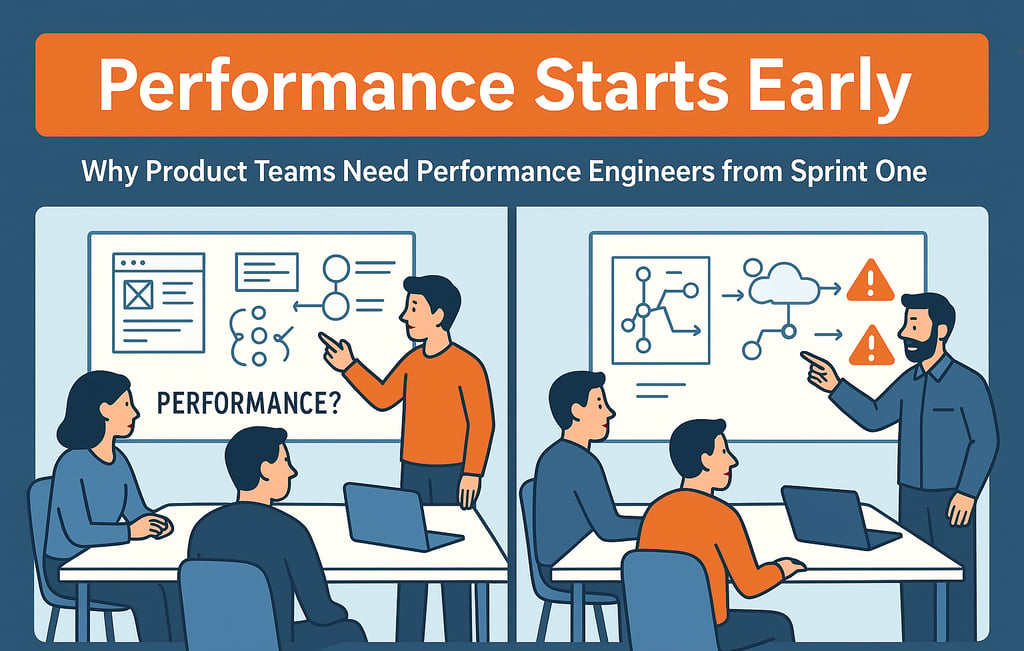Why involve Performance Engineers early in Product Development
PERFORMANCE
Deepak Jha
4/18/20253 min read


In many modern product development setups, performance engineering is often treated as an afterthought—a gate to be passed just before a release goes live. It's a pattern repeated across industries: the initial sprints are laser-focused on getting functional features working, with the assumption that performance optimization can "wait." Unfortunately, this is a misstep that can prove costly down the line.
The Common Misconception: “It’s Too Early for Performance Engineering”
A frequent argument heard in product circles is, "We’re still finalizing the product design," or "Let's focus on functionality first—performance can come later." This mindset may stem from a well-intentioned desire to build something tangible before optimizing it. However, what often goes unrecognized is that some of the most critical performance pitfalls stem from foundational design decisions made in those very early stages.
Why does this perception persist?
Inexperience and Burnt Fingers
The truth is, many stakeholders have had poor experiences with so-called “performance testers” who enter projects late, run a few scripts, report a bunch of issues without real context, and disappear. These individuals often lack the architectural understanding or technical depth required to provide actionable insights. When teams engage with such resources, they naturally conclude that performance engineering isn’t very useful—or worse, just adds noise to their backlog.
This has unfortunately led to a reputation problem: experienced performance engineers who can truly shape the product for scalability and responsiveness are often painted with the same brush. And so, performance is sidelined until a late-stage testing phase, where it's treated as a checkbox rather than a core feature.
The Missed Opportunity: Insightful Design Validation
Bringing in an experienced performance engineer early can be a game-changer. Here's how:
Architectural Review: Even before a single line of production code is written, performance engineers can evaluate architectural artifacts like database schemas, dataflow diagrams, and service dependencies. Just by reviewing design documents, they can identify bottlenecks—whether it's a synchronous call chain, an inefficient query pattern, or an ill-suited messaging layer.
Use Case Analysis: Early involvement enables the team to map out high-impact use cases and user journeys that will stress the system. This ensures the architecture supports them from the outset rather than needing major rework later.
Latency and Scalability Lens: Especially in applications expected to serve a large user base or handle high data throughput, performance engineers can flag areas of concern early—before they turn into firefighting issues during go-live.
Early engagement isn’t about catching developers off-guard—far from it. When done well, it fosters a collaborative environment where everyone on the team becomes conscious of performance implications.
By working alongside developers in the initial sprints:
Engineers begin thinking about efficient coding practices naturally.
API designs factor in response times and payloads.
Logging and telemetry are implemented with performance monitoring in mind.
Performance becomes a design mindset, not just a QA phase.
The result? A product where performance is a feature, not a late-stage quality gate.
How a Performance Engineer Should Engage Early
As a performance engineer if you are involved from the early stages of a project, here's how to ensure your role complements development efforts:
Build Trust Through Understanding: Start by learning the product goals, user personas, and functional requirements. Understand the business context before diving into tech suggestions. I have seen too many examples where even experienced technical experts jump into preacher mode even before they fully understand the product. Such inputs are not at all constructive and only breaks the trust.
Contribute to Architecture Reviews: Ask the right questions. Where are the asynchronous boundaries? What’s the estimated load? Is there a cache strategy? What are the projections expected from based on the business roadmap around the product? Based on These conversations build credibility and trust.
Prototype Thoughtfully: Build lightweight test scenarios or simulate expected traffic patterns to validate key flows. This helps guide development without dictating it.
Educate Without Preaching: Help developers understand the impact of certain coding or design choices, but do it as a partner, not as a gatekeeper.
Leverage Observability: Use early telemetry and APM tools to give the team visibility into how their code behaves even in dev or staging. Shared awareness is powerful.
Performance engineering is not just about running load tests—it's about building products that perform, scale, and delight users under real-world conditions. Involving performance engineers early in the product development lifecycle is not just a best practice—it’s a competitive advantage.
The earlier product teams embrace it, the fewer surprises they will have later. And the users will thank you for it.
